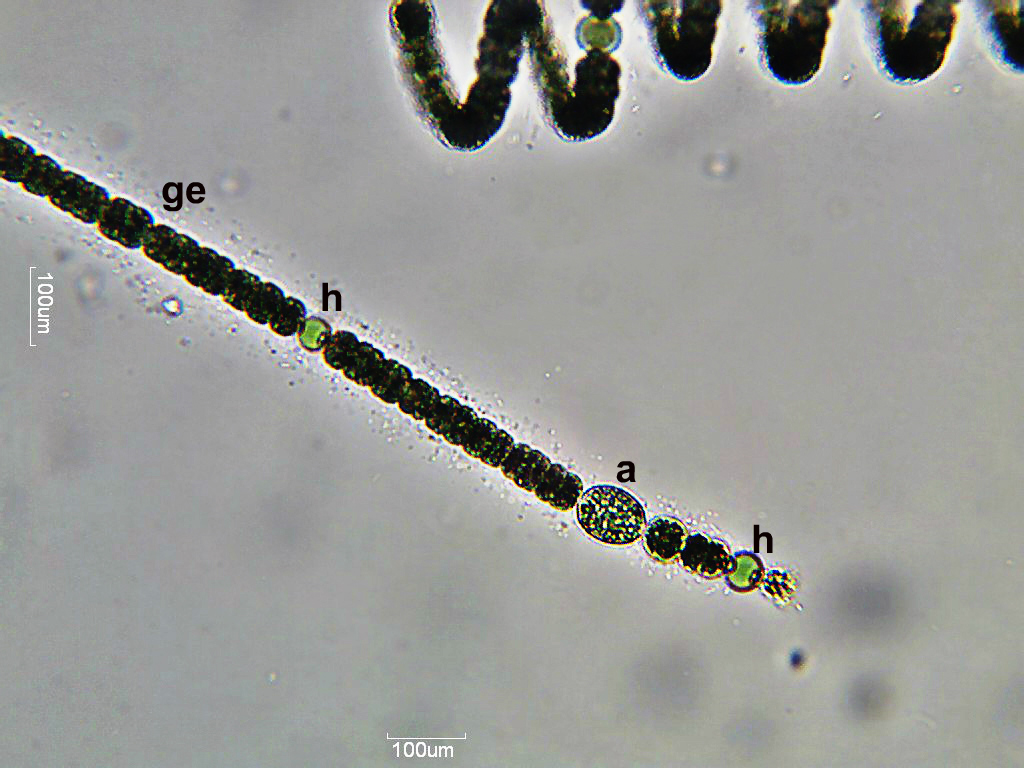Dolichospermum (Ralfs ex Bornet & Flahault) P. Wacklin, L. Hoffmann & J. Komárek 2009
Key # 22
1.) Classification: Order Nostocales, Family Aphanizomenonaceae. There are currently
about 45 described species. The genus Dolichospermum was separated from the genus
Anabaena based on analyses of the 16S rRNA region of these organism's genome
(Wacklin et. al. 2009; Komárek and Zapomělová 2007, 2008). The 16S rRNA region is
of interest because it is part of the biochemical machinery that “reads” DNA during
protein synthesis. It is thought to be more stable and to undergo less change than the
rest of the genome. When all members of the previous Anabaena genus were compared,
a subgroup was found that was genetically different from the other Anabaena, and its
members were very similar to each other (> 92%). These studies also showed that the
members of this distinct group were also quite different from Anabaena in terms of their
cellular structure and habitat. There will probably be future refinements in
classification of these broad and diverse genera as new techniques add to our knowledge.
2.) Form: Filamentous.
3.) Groups: Floating, solitary filaments or in a few small, irregular clusters.
4.) Sheath: No sheath, but sometimes there is a fine, colorless, diffluent gelatinous envelope.
5.) Filaments: Cylindrical; metameric; straight to slightly curved or flexuous to infrequently
coiled like a screw; isopolar (consistent diameter, no tapering); usually with
conspicuous crosswall constrictions.
6.) Cells: Spherical to barrel shaped to almost cylindrical; usually isodiametric but can be up
to twice as long as wide. Apical or terminal cells appear the same as vegetative cells but
are rounded at the ends; they are not differentiated and are able to divide.
Heterocysts: Spherical to barrel shaped, about the same width as vegetative cells.
Usually solitary, intercalary, and develop from vegetative cells in a regular pattern, equal
in distance in mature filaments. They are terminal only after filament disintegration.
Akinetes: Variable in shape and position. They can be cylindrical to oval to spherical,
solitary or in short rows (< 5), beside or several cells distant from the heterocysts
(paraheterocytic), and usually intercalary. They are often the fusion product of
2–3 vegetative cells. Mature akinetes can be more than 3X larger than vegetative cells.
Aerotopes: Obligatory in vegetative cells that can be joined into irregular structures over
the cell volume. They can be dark in appearance because of refraction.
7.) Color: Light green to blue green; can appear dark because of aerotopes.
8.) Replication: Fragmentation or akinete production.
9.) Habitat: A very common genus reported worldwide, but mostly in temperate zones.
They are planktonic in freshwater mesotrophic (rarely oligotrophic or eutrophic) lakes,
where they can form dense surface blooms. They never form sessile mats on substrates.
10.) Similar genera: Some Anabaena species may appear to be similar, but their habitats and
growth forms are quite different. Dolichospermum is described as a planktonic Anabaena.
Dolichospermum is usually solitary and planktonic, so it usually has aerotopes.
Anabaena is rarely solitary, grows on substrates and never has aerotopes.
11.) Toxins: Microcystins, anatoxin-a, anatoxin-a(S), and saxitoxins are reported.
12.) Distinguishing features: Dolichospermum has moniliform, planktonic filaments,
usually with aerotopes. MAN

Dolichospermum_01
Dolichospermum is a filamentous planktonic cyanobacteria with straight to coiled
filaments with conspicuous crosswall constrictions between the cells. They are
described as moniliform – looking like beads on a string. Cells are variable from
spherical to almost barrel-shaped with dense aerotopes. Heterocyts often have
plugs on either end and are intercalary. There are two different varieties in this
photomicrograph. This sample was from a plankton tow from Birch Tree Lake,
Independence, KY, USA taken on October 06, 2016. 400X Magnification.

Dolichospermum_02
Dolichospermum is a filamentous planktonic cyanobacteria with straight to coiled
filaments with conspicuous crosswall constrictions between the cells. They are
moniliform – looking like beads on a string. Cells are variable from spherical to
almost barrel-shaped with dense aerotopes. Heterocyts (h) often have plugs on
either end and are intercalary. Akinetes (a) are larger and more oval than vegetative
cells. A gelatinous envelope (ge) can be seen in this image. This sample was from
a plankton tow from Long Lake, Mills Road Park, Independence, KY, USA taken
on July 05, 2016. 400X Magnification.

Dolichospermum_03
Dolichospermum is a filamentous planktonic cyanobacteria with straight to coiled
filaments with conspicuous crosswall constrictions between the cells. They are
moniliform – looking like beads on a string. Cells are variable from spherical to
almost barrel-shaped with dense aerotopes. Heterocyts (h) often have plugs on
either end and are intercalary. There are two different varieties in this image.
This sample was from a plankton tow from Birch Tree Lake, Independence, KY,
USA taken on October 06, 2016. 400X Magnification.

Dolichospermum_04
Dolichospermum is a filamentous planktonic cyanobacteria with straight to coiled
filaments with conspicuous crosswall constrictions between the cells. They are
moniliform – looking like beads on a string. Cells are variable from spherical to
almost barrel-shaped with dense aerotopes. Heterocyts (h) often have plugs on
either end and are intercalary. Akinetes (a) are larger and more oval than vegetative
cells. This sample was from a plankton tow from Shelterhouse Lake, Mills Road
Park, Independence, KY, USA taken on June 03, 2016. 400X Magnification.